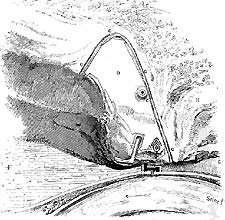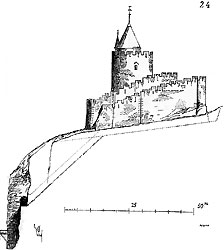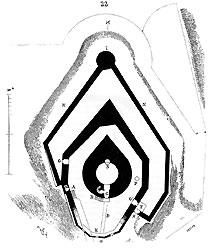

Essonne |
Paris |
Seine et Marne |
Val d'Oise |
Val de Marne |
Yvelines |
Other regions & other castles |
Previous months’ selections |
| Castle of the Roche Guyon |
|
|
1 - Geographical situation
2 - Description of the site It is there that at the end of XIe century a castle under excellent conditions was high. Initially a keep very extremely surrounded by a double enclosure was high at the top of the escarpment. Along the river and leaned with the rock which dominates it of much, drew up the castle which cut the road passing on right bank, ordered the course of the river and, consequently, the top of the peninsula. In order to bring closer as much as possible the castle the keep, the chalk escarpment was cut à.pic, so as to leave a rather vast court between the principal building and the foot of the rock. A broad diverted underground, cut in the rock and having the figure of a cylinder with emmarchement, joins together defenses of the castle at the interior court of the keep. Side where the escarpment was less abrupt, was distinct, in the sharp rock, broad and deep ditch à.fond of tank. A less deep ditch, but much wider, circumvented the plate on the end of which the keep sat; but as this plate was not level and than it dominated the keep while being inserted in the chalky chain, one made a factitious mound on which (probably) a defense rose, destroyed today. The natural escarpments were to remove any idea to attack the plate by its sides. We do not think that the ditch and the escarpment were ever protected by walls, but only by one ground lifting with palisades, because it does not remain on these points null trace of masonries.
In order to better
do to still include/understand the plate of the castle of the Rock-Guyon,
and how, by considerable works, one had managed to make this plate
even stronger, either by notching the hill, or by making earthworks,
we give a profile of the chalk escarpment with constructions. In
A is the Seine, out of B the castle built with the foot of cliff,
out of C the keep, of which the enclosures rise while following
the angle of rest of the plate to dominate the outside on the side
D. In E, the made mound with hand of man, on whom was a advanced
work ordering the circumvallation of the plate; the profile of the
underground communicating of the castle to the keep is traced in
H. One could not enter, of the plate, in the enclosures of the keep
that by a postern bored on the side of the courtine external of
right-hand side and facing the escarpment, in manner that it was
impossible to see this entry either of the Text of Eugène Viollet le Duc 3 - The keep
|
|
Castle of the month : |
Search |
For any question concerning this Web site, send a message to webmaster

 Below
Mantes, the Seine runs towards the west; in Rolleboise, it is diverted
towards the North-East, forms a vast elbow, returns towards south-west,
and thus leaves, on left bank, a peninsula of alluvia of which the
length is approximately eight kilometers and the greatest width
of four. The throat of this peninsula hardly has but two kilometers
of opening. It was a place of excellent camping there, because an
army corps, whose right-hand side was supported on Bonnières
and the left with Rolleboise, defended without sorrow the entry
of the peninsula. But it was necessary to provide that an enemy
in forces, by attacking the throat, could, while slipping by along
right bank, to try to pass the Seine at the end of the plain of
Bonnieres and to thus take the peninsula by its two most distant
points. However the right bank, opposite the peninsula of Bonnières,
is composed of an escarpment chalky, abrupt, which approaches the
Seine with Vétheuil, to leave it with the Rock-Guyon at the
top of its elbow. On this point, with the Rock-Guyon, the escarpment
is far away from the river only of approximately one hundred meters;
formerly it was still brought closer more it, the Seine having moved
back its banks.
Below
Mantes, the Seine runs towards the west; in Rolleboise, it is diverted
towards the North-East, forms a vast elbow, returns towards south-west,
and thus leaves, on left bank, a peninsula of alluvia of which the
length is approximately eight kilometers and the greatest width
of four. The throat of this peninsula hardly has but two kilometers
of opening. It was a place of excellent camping there, because an
army corps, whose right-hand side was supported on Bonnières
and the left with Rolleboise, defended without sorrow the entry
of the peninsula. But it was necessary to provide that an enemy
in forces, by attacking the throat, could, while slipping by along
right bank, to try to pass the Seine at the end of the plain of
Bonnieres and to thus take the peninsula by its two most distant
points. However the right bank, opposite the peninsula of Bonnières,
is composed of an escarpment chalky, abrupt, which approaches the
Seine with Vétheuil, to leave it with the Rock-Guyon at the
top of its elbow. On this point, with the Rock-Guyon, the escarpment
is far away from the river only of approximately one hundred meters;
formerly it was still brought closer more it, the Seine having moved
back its banks.
 plate, or of the bottom of the escarpment Our profile makes include/understand
how it was difficult with one besieging to be held in the lower
castle without having the higher keep at the same time; if, after
having seized the castle, he had wanted to place himself there,
he was infallibly crushed by the garrison of the keep.As for seizing
the keep, wrapped in his double enclosure, one could try it only
by one blockade. But how to block a fortress which had a very practicable
underground exit communicating with a ordered lower defense and
a broad river? Under the strategic report/ratio, the position of
the castle of the Rock-Guyon was thus excellent and obviously selected
to keep this peninsula of Bonnière so easy to defend with
the throat. Two or three thousand men in the peninsula and four
or five hundred men in the castle and its dependences resting mutually,
though separated by the Seine, could stop a considerable army and
paralyse its movements on one or the other bank of the Seine.
plate, or of the bottom of the escarpment Our profile makes include/understand
how it was difficult with one besieging to be held in the lower
castle without having the higher keep at the same time; if, after
having seized the castle, he had wanted to place himself there,
he was infallibly crushed by the garrison of the keep.As for seizing
the keep, wrapped in his double enclosure, one could try it only
by one blockade. But how to block a fortress which had a very practicable
underground exit communicating with a ordered lower defense and
a broad river? Under the strategic report/ratio, the position of
the castle of the Rock-Guyon was thus excellent and obviously selected
to keep this peninsula of Bonnière so easy to defend with
the throat. Two or three thousand men in the peninsula and four
or five hundred men in the castle and its dependences resting mutually,
though separated by the Seine, could stop a considerable army and
paralyse its movements on one or the other bank of the Seine. 

